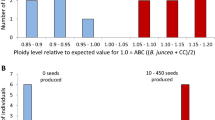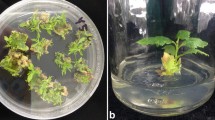Abstract
A triploid hybrid with an ABC genome constitution, produced from an interspecific cross between Brassica napus (AACC genome) and B. nigra (BB genome), was used as source material for chromosome doubling. Two approaches were undertaken for the production of hexaploids: firstly, by self-pollination and open-pollination of the triploid hybrid; and secondly, by application of colchicine to axillary meristems of triploid plants. Sixteen seeds were harvested from triploid plants and two seedlings were confirmed to be hexaploids with 54 chromosomes. Pollen viability increased from 13% in triploids to a maximum of 49% in hexaploids. Petal length increased from 1.3 cm (triploid) to 1.9 cm and 1.8 cm in the two hexaploids and longest stamen length increased from 0.9 cm (triploid) to 1.1 cm in the hexaploids. Pollen grains were longer in hexaploids (43.7 and 46.3 μm) compared to the triploid (25.4 μm). A few aneuploid offsprings were also observed, with chromosome number ranging from 34 to 48. This study shows that trigenomic hexaploids can be produced in Brassica through interspecific hybridisation of B. napus and B. nigra followed by colchicine treatment.




Similar content being viewed by others
References
Abraha E, Klíma M, Vyvadilová M, Bechyn M (2008) Effectiveness of selected antimitotic agents in microspore culture for Brassica carinata doubled haploid production. Agric Trop et Subtrop 41:137–149
Adamowski EV, Pagliarini MS, Valle CB (2008) Meiotic behavior in three interspecific three-way hybrids between Brachiaria ruzizensis and B. brizantha (Poaceae: Paniceae). J Genet 87:33–38
Altmann T, Damm B, Frommer WB, Martin T, Morris PC, Schweizer D, Willmitzer L, Schmidt R (1994) Easy determination of ploidy level in Arabidopsis thaliana plants by means of pollen size measurement. Plant Cell Rep 13:652–656
Arnold ML (1997) Natural hybridization and evolution. Oxford University Press, New York
Barnabás B, Obert B, Kovács G (1999) Colchicine, an efficient genome-doubling agent for maize (Zea mays L.) microspores cultured in anthero. Plant Cell Rep 18:858–862
Benavente E, Cifuentes M, Dusautoir JC, David J (2008) The use of cytogenetic tools for studies in the crop-to-wild gene transfer scenario. Cytogenet Genome Res 120:384–395
Burton TL, Husband BC (2001) Fecundity and offspring ploidy in matings among diploid, triploid and tetraploid Chamerion angustifolium (Onagraceae): consequences for tetraploid establishment. Heredity 87:573–582
Chiang BY, Grant WF, Chiang MS (1978) Transfer of resistance to race 2 of Plasmodiophora brassicae from Brassica napus to cabbage (B. oleracea var. capitata). II. Meiosis in the interspecific hybrids between B. napus and 2x and 4x cabbage. Euphytica 27:81–93
Comai L (2005) The advantages and disadvantages of being polyploid. Nature 6:836–846
Dubcovsky J, Dvorak J (2007) Genome plasticity a key factor in the success of polyploid wheat under domestication. Science 29:1862–1866
Duke JA (1983) Handbook of energy crops. Center for new crops and plant products, Purdue University. http://www.hort.purdue.edu/newcrop/duke_energy/Brassica_nigra.html. Accessed 28 Dec 2006
Ellneskog-Staam P, Merker A (2001) Genome composition, stability and fertility of hexaploid alloploids between Triticum turgidum var. carthlicum and Leymus racernosus. Hereditas 134:79–84
Ford JH, Schultz CJ, Correll AT (1988) Chromosome elimination in micronuclei: a common cause of hypoploidy. Am J Hum Genet 43:733–740
Gland A (1981) Doubling chromosomes in interspecific hybrids by colchicine treatment. Cruciferae Newslett 6:20–22
Guedes-Pinto H, Darvey N, Carnide VP (1996) Developments in plant breeding Triticale: today and tomorrow. Kluwer Academic Publishers, The Netherlands
Guzy MR, Ehdaie B, Waines JG (1989) Yield and its components in diploid, tetraploid and hexaploid wheats in diverse environments. Ann Bot 64:635–642
Hamill SD, Smith MK, Dodd WA (1992) In vitro induction of banana autotetraploids by colchicine treatment of micropropagated diploids. Aust J Bot 40:887–896
Jenczewski E, Eber F, Grimaud A, Huet S, Lucas MO, Monod H, Chevre AM (2003) PrBn, a major gene controlling homeologous pairing in oilseed rape (Brassica napus) haploids. Genetics 164:645–653
Johnstone FE (1939) Chromosome doubling in potatoes induced by colchicine treatment. Am J Potato Res 16:288–304
Koch WDJ (2004) Black mustard. Plants for a future. http://www.pfaf.org/database/plants.php? Brassica+nigra. Accessed 5 Jan 2007
Lage J, Trethowan RM (2008) CIMMYT’s use of synthetic hexaploid wheat in breeding for adaptation to rainfed environments globally. Aust J Agric Res 59:461–469
Leitch AR, Leitch IJ (2008) Genomic plasticity and the diversity of polyploidy plants. Science 320:481–483
Levin DA (2002) The role of chromosomal change in plant evolution. Oxford University Press, New York
Li Z, Liu HL, Luo P (1995) Production and cytogenetics of intergeneric hybrids between Brassica napus and Orychophragmus violaceus. Theor Appl Genet 91:131–136
Li M, Qian W, Meng J, Li Z (2004) Construction of novel Brassica napus genotypes through chromosomal substitution and elimination using interploid species hybridization. Chromosome Res 12:417–426
Lichtenzveig J, Abbo S, Nerd A, Tel-Zur N, Mizrahi Y (2000) Cytology and mating systems in the climbing cacti Hylocereus and Selenicereus. Am J Bot 87:1058–1065
Lysak MA, Koch MA, Pecinka A, Schubert I (2005) Chromosome triplication found across the tribe Brassiceae. Genome Res 15:516–525
Meng JL, Shi S, Li G, Li Z, Qu X (1998) The production of yellow-seeded Brassica napus (AACC) through crossing interspecific hybrids of B. campestris (AA) and B. carinata (BBCC) with B. napus. Euphytica 103:329–333
Nelson MN, Lydiate D (2006) New evidence from Sinapis alba L. for ancestral triplication in a crucifer genome. Genome 49:230–238
Nelson M, Mason A, Castello M-C, Thomson L, Yan G, Cowling W (2009) Microspore culture preferentially selects unreduced (2n) gametes from an interspecific hybrid of Brassica napus L. × Brassica carinata Braun. Theor Appl Genet 119:497–505
Nicolas SD, Leflon M, Liu Z, Eber F, Chelysheva L, Coriton O, Chèvre AM, Jenczewski E (2008) Chromosome ‘speed dating’ during meiosis of polyploid Brassica hybrids and haploids. Cytogenet Genome Res 120:331–338
Olsson G (1960) Species crosses within the genus Brassica II. Artificial Brassica napus L. Hereditas 46:351–386
Porter PM, LeGare DG (2006) Canola. Varietal trial results. Minnesota Agricultural Experiment Station, University of Minnesota. http://www.maes.umn.edu/06VarietalTrials/canola.pdf. Accessed 8 Jan 2006
Pradhan A, Plummer JA, Nelson MN, Cowling WA, Yan G (2010) Trigenomic hybrids from interspecific crosses between Brassica napus and B. nigra. Crop Pasture Sci 61:464–474
Qian W, Chen X, Fu D, Zou J, Meng J (2005) Intersubgenomic heterosis in seed yield potential observed in a new type of Brassica napus introgressed with partial Brassica rapa genome. Theor Appl Genet 110:1187–1194
Rahman MH (2001) Production of yellow-seeded Brassica napus through interspecific crosses. Plant Breed 120:463–472
Riley R, Chapman V (1958) Genetic control of the cytologically diploid behaviour of hexaploid wheat. Nature 13:713–715
Saisingtong S, Schmid JE, Stamp P, Buter B (1996) Colchicine mediated chromosome doubling during anther culture of maize (Zea mays L). Theor Appl Genet 92:1017–1023
Sears ER, Okamoto M (1958) Intergenomic chromosome relationships in hexaploid wheat. In: Proc 10th Int Cong Genet, vol 2, pp 258–259
Shahriari-Ahmadi F, Dehghan E, Farsi M, Azizi M (2008) Tetraploid induction of Hyoscyamus muticus L. using colchicine treatment. Pak J Biol Sci 11:2653–2659
Sjödin C, Glimelius K (1989) Brassica naponigra, a somatic hybrid resistant to Phoma lingam. Theor Appl Genet 77:651–656
Srivastava HK, Sarkissian IV (1970) Comparative studies of functions of mitochondria from a polyploid series of wheat. Genetics 66:497–503
Takashima H, Hasegawa H, Nakamura A (1995) A simple method for chromosome doubling in tobacco anther culture. Breed Sci 45:107–110
Tambong JT, Sapra VT, Garton S (1998) In vitro induction of tetraploids in colchicine-treated cocoyam plantlets. Euphytica 104:191–197
Tel-Zur N, Abbo S, Mizrahi Y (2005) Cytogenetics of semi-fertile triploid and aneuploid intergeneric vine cacti hybrids. J Hered 96:124–131
Tsuchiya T, Larter EN (1971) Further results on chromosome stability of hexaploid triticale. Euphytica 20:591–596
U N (1935) Genome-analysis in Brassica with special reference to the experimental formation of B. napus and peculiar mode of fertilization. Jpn J Bot 7:389–452
Yan G, Nelson M, Pradhan A, Mason A, Weerakoon SR, Si P, Plummer J and Cowling W (2009) Progress towards the creation of trigenomic Brassica hexaploid populations. 14th Australasian Plant Breeding Conference/11th SABRAO Conference, Cairns, Australia. (To be published in SABRAO J Breed Genet, vol 41)
Zhao J, Simmonds DH, Newcomb W (1996) High frequency production of doubled haploid plants of Brassica napus cv. Topas derived from colchicine-induced microspore embryogenesis without heat shock. Plant Cell Rep 15:668–671
Zou J, Zhu J, Huang S, Tian E, Xiao Y, Fu D, Tu J, Fu T, Meng J (2010) Broadening the avenue of intersubgenomic heterosis in oilseed Brassica. Theor Appl Genet 120:283–290
Acknowledgements
This research is supported by Co-operative Bulk Handling Pty Ltd and the Faculty of Natural and Agricultural Sciences at The University of Western Australia, and UPA (University Postgraduate Award) scholarship to Aneeta Pradhan. We thank Winthrop Professor Kadambot Siddique for valuable support; Dr MarieClaire Castello, Dr Chhaya Atri, Dr Made Pharmawati and Cui Cheng for technical help and Damber Bahadur Shrestha for his help with the statistical analysis using SAS 9.2 software.
Author information
Authors and Affiliations
Corresponding author
Rights and permissions
About this article
Cite this article
Pradhan, A., Plummer, J.A., Nelson, M.N. et al. Successful induction of trigenomic hexaploid Brassica from a triploid hybrid of B. napus L. and B. nigra (L.) Koch. Euphytica 176, 87–98 (2010). https://doi.org/10.1007/s10681-010-0218-8
Received:
Accepted:
Published:
Issue Date:
DOI: https://doi.org/10.1007/s10681-010-0218-8




